Menu



Cordyceps mushrooms seem to be all the rage right now. You see them in every adaptogen and pre-workout supplement. They’re being talked about extensively in the mushroom community and are among the top superfoods purported to have numerous health benefits.
So, what is all the hype surrounding this fascinating fungus? First, let’s explore what this fungus is and how it can benefit your health. Then, we will look at the common variations of Cordyceps on the market and help decipher what to look for in a Cordyceps supplement.
Cordyceps mushrooms are parasitic fungi that include over 400 different species. They grow all over the world in countries like China, Japan, India, the United States, Australia, Peru, Bolivia, and many more. They typically infect insects and arthropods, with each species of Cordyceps infecting a very specific bug.
The life cycle begins with Cordyceps spores landing on the insect. The spore germinates, and small thread-like filaments called hyphae will begin to grow inside the insect and turn into mycelium. The mycelium (the fungi’s root-like structure that will develop into a mushroom) continues to consume the insect from the inside.
When the fungal mycelium fully consumes the insect, and the environmental conditions are correct, a blade-like mushroom (fruiting body) is produced from the insect’s head. The mushroom then releases spores, and the life cycle starts over.
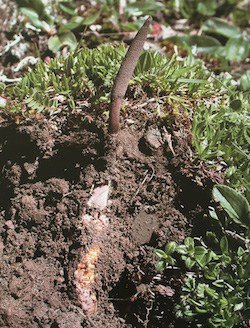
Here is a BBC Planet Earth clip of Cordyceps infecting ants:
Even the popular video game The Last of Us, feature Cordyceps as the main antagonist. In it, a mutant Cordyceps strain infects humans creating “Cordyceps zombies.” And no, Cordyceps does not really infect humans.
There are two types of Cordyceps mushrooms (fruiting bodies) that you can buy: Cordyceps sinensis and Cordyceps militaris.
We give a brief overview of the differences between the two below. However, we encourage you to read our article, Cordyceps Sinensis vs Militaris: What’s the Best Cordyceps Supplement? for a better understanding of each type. The article explains which of these two varieties is preferable over the other when it comes to supplementing with this mushroom.
The most well-known species of Cordyceps mushrooms is Cordyceps sinensis (now known officially as Ophiocordyceps sinensis), which infects the caterpillar of the Hepialus moth. It mainly grows at high elevations in Tibet and the Chinese provinces of Sichuan, Yunnan, Qinghai and Gansu. It can also be found in India, Nepal, and Bhutan, but is less abundant there.
In Tibet, it is known as Yarsagumba or yartsa gunbu and in China it is known as Dōnɡ Chónɡ Xià Cǎo (冬虫夏草), which translate to summer grass, winter worm.
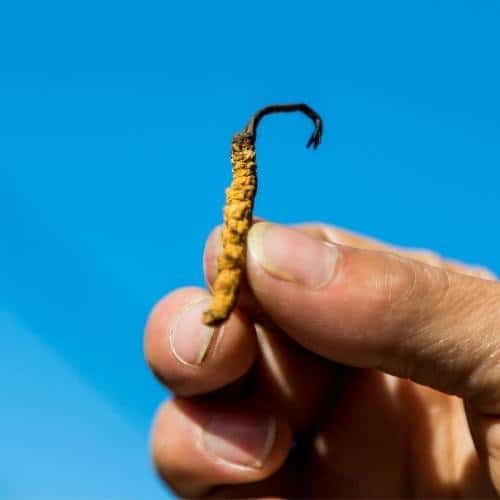
Wild Cordyceps sinensis (shown above) is not in 99.9% of Cordyceps supplements because of its exceptionally high price tag. In fact, wild Cordyceps sinensis costs over $20,000 per kilogram, making it the most expensive mushroom in the world. It is almost exclusively sold in Asia and rarely reaches the North American market.
The high price tag of Cordyceps sinensis mushrooms (including the caterpillar) is due to the fact that for many years, Chinese scientists have been unable to cultivate this mushroom. This has fueled increased demand for a set supply of wild Cordyceps sinensis. Recently Chinese scientists figured out how to cultivate this mushroom, but it is not at a production scale yet to make an impact on wild Cordyceps sinensis prices.
So, don’t expect to readily (or affordably) be able to get your hands on this pricey mushroom.
There is currently one type of Cordyceps species that can be commercially cultivated at scale to produce a mushroom (fruiting body), and it is becoming quite popular for use in supplements. This is Cordyceps militaris.
Cordyceps militaris is known as Scarlet Club Fungus or Caterpillar Killer in the U.S. It is the Cordyceps species that can grow on the largest variety of insects and is widely found in North America and Asia. It is commonly found in the mountains, in bogs.
This Cordyceps variety can be commercially cultivated at scale rather easily. By using Cordyceps militaris, for the first time, true Cordyceps mushroom extracts can be made.
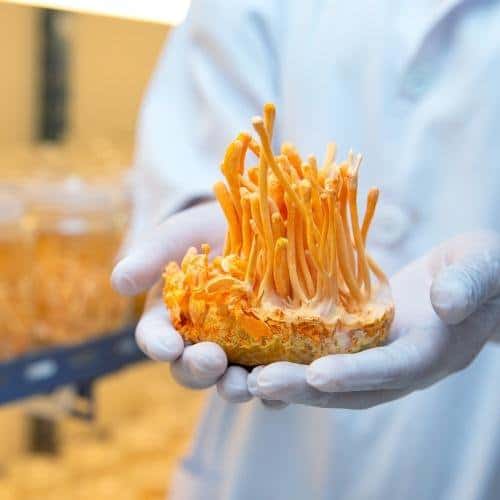
Now that we’ve dispelled much of the misinformation about Cordyceps, let’s examine some of its health benefits.
In Traditional Chinese Medicine (TCM), Cordyceps mushrooms are considered a very special tonic. Called Dōnɡ Chónɡ Xià Cǎo (冬虫夏草), these mushrooms were offered to the Emperor’s court and others among the Chinese nobility.
The first written traditional Chinese medicine record was mentioned in the year AD 620. Traditionally, it was used as a lung and kidney tonic, making it useful for respiratory complaints, physical tiredness, and those with a weak constitution. Sexual function, libido, and performance are also keynotes for Cordyceps mushrooms’ use in traditional Chinese medicine.
Cordyceps is considered a jing tonic by nourishing yin, boosting yang, and supporting kidney essence. Essence is considered to be the elixir of life in Traditional Chinese Medicine. Essence comes from lifestyle (post-natal qi: breathing, diet, meditation, mushrooms, and herbs) or from energetic reserves we are born with (pre-natal qi). Cordyceps is considered to be equal to other valued tonics like ginseng, reishi and deer antler velvet.
Cordyceps mushrooms have a sweet flavor and are slightly warm in energetics. These more subtle qualities of Cordyceps are used to make sure Cordyceps isn’t used in the wrong scenarios. For example, due to the stimulating and strengthening nature of Cordyceps mushrooms, they are contraindicated in conditions with lung heat based on their ability to not only strengthen the person but also the current state of the body.
There have been 50 medicines and two Cordyceps supplements approved in China since 2002.
When considering the use of Cordyceps in traditional Chinese medicine, think of vigor and vitality. Traditionally recognized benefits of cordyceps include strengthening, rebuilding, and energizing the body and mind.
The potential health benefits of Cordyceps for exercise performance involve its energizing properties. Supplements of Cordyceps mushrooms showed improved exercise performance in healthy older patients, as demonstrated by an increased respiratory capacity and metabolic functioning (44). This study included 20 healthy elderly individuals ages 50-75.
One group was the control, and the other group took 999 mg of Cs-4 (three 333-mg capsules) per day. The subjects performed the stationary cycle ergometer using breath-by-breath examination at baseline and the end of the study.
The results were quite good! Following 12 weeks of Cs-4 supplementation, the healthy elderly individuals’ lactate threshold increased by 10.5%, and their ventilatory threshold increased by 8.5%. On the other hand, the control group saw no changes in VO2 max (5).
Similar results were shown in a randomized double-blind placebo-controlled clinical trial, which showed a 7% improvement in VO2max in healthy older individuals, this time in a bigger sample size (48).
A small human study showed that Cordyceps has no effect on aerobic capacity in trained athletes. The researchers theorize that trained athletes are already close to their aerobic capacity, and Cordyceps’ mechanisms of action have less of an effect (45).
Another human study supported the use of Cordyceps on energy and sympathetic activation during exercise (49), supporting the potential health benefits of cordyceps supplements for improving exercise performance biomarkers.
Animal studies show that the polysaccharides in Cordyceps mushrooms can have an anti-tiredness effect and improve exercise performance biomarkers (46). One such study found that rodents who received two weeks of Cordyceps militaris (CM) supplementation displayed greater levels of delayed tiredness compared to rodents not given Cordyceps militaris.
Not only that, but the CM rodent group had higher levels of ATP, antioxidant enzyme levels and best of all, lower levels of lactic acid (a key component affecting tiredness and time to exercise-induced exhaustion). In other words, these rodents were able to push longer and harder without tiring out as quickly (8). These lab studies suggest cordyceps have the potential to enhance overall stamina and energy.
Cordyceps mushrooms have been documented to have antioxidative effects (50). In theory, this could support athletes during and after their performance. Recovery is critical for athletes of all levels. Athletes using Cordyceps to improve exercise performance biomarkers should also consider its recovery potential.
Conveniently, Cordyceps is a key ingredient in a blend that Real Mushrooms has recently launched to help support your energy, stamina, and vitality. Our Real Boost supplement is paired with other herbs such as Guayusa and Ginseng extract, for optimal effects.
For more information about using Cordyceps mushrooms and other functional fungi to support exercise performance and athletics, read our article on Stimulant-Free Pre-Workout & Post-Workout Mushroom Supplements.
Preliminary human and animal cell studies suggest Cordyceps may support healthy levels of inflammation and immune markers (15, 16, 17, 18, 19, 20). Beta-glucans and cordycepin in Cordyceps militaris have been theorized to be the main compounds responsible for their apparent ability to support a healthy inflammation response (14, 23).
Mouse studies on blood sugar balance suggest that Cordyceps mushrooms may support the health of pancreatic beta cells (21). The immunomodulating and inflammation-balancing properties of Cordyceps may help rebalance the T regulatory and Th17 cell ratio seen in one mouse study (22).
Age-related inflammation of the cells and mitochondria can be influenced by free radicals and reactive oxygen species (ROS). In vitro and in vivo animal research suggests Cordyceps helps oxygen delivery at a cellular level, which may support a healthy inflammation response (25).
Animal research indicates Cordyceps mushrooms and herbal supplements may have an effect on adenosine receptors, which explains their ability to support a healthy inflammation response (55, 56). These findings highlight the potential health benefits of incorporating Cordyceps into one's wellness routine.
Traditionally, Cordyceps mushrooms were used as an aphrodisiac to support sexual performance and healthy libido. Modern science indicates they may support healthy levels of androgens in men.
One animal study showed that Cordyceps helped mitigate the impact of bisphenol A (BPA, a hormone-disrupting plastic) on the reproductive system while supporting healthy testosterone production levels, sperm motility, and sperm count (26).
Cordycepin may support healthy steroidogenic acute regulatory (STAR) enzyme, which allows the starting substrate of all hormones, cholesterol, to enter the mitochondria for the production of steroid hormones. Cholesterol is converted to pregnenolone and pregnenolone to testosterone (27, 28).
Many individuals looking to support healthy levels of testosterone often make the mistake of overtraining. Overtraining can lead to an increase in free radicals, leading to oxidative stress and a negative impact on the hypothalamus, pituitary, adrenal and gonadal axis (29). Cordyceps mushrooms also have abundant anti-oxidative properties (30).
A pilot endurance athlete study (7 participants) showed that Cordyceps supplementation combined with reishi mushroom supplementation decreased overtraining markers and supported a healthy testosterone-to-cortisol ratio. This same study showed decreases in oxidative stress (32).
A small study sample (16 participants) showed that young, healthy male adults showed no support of physical endurance or testosterone production levels when supplementing with 2.4g/day of cordyceps (33). Again, this may be similar to the VO2 max studies showing that Cordyceps may have less effect on physically fit individuals.
Less may be more when it comes to dosing for hormonal-balancing effects; a few of these animal studies showed better results with the lower dosage of herbal supplements (1% vs 5%).
Cordyceps mushrooms were used traditionally to support libido and all things related to sexual functioning, but clinical studies are lacking in this area.
Most in vitro studies and in vivo animal studies suggest that Cordyceps’ libido-enhancing effects may come from its hormone-supportive actions.
A study on individuals with low libido treated with cultured Cordyceps showed a 64.5% subjective improvement (41). A 2016 review referenced a Cordyceps study that increased libido and sexual performance in men and women (62).
One other thing to consider is that functional mushrooms may be 5-alpha-reductase (5AR) inhibitors, which could prevent testosterone from being converted to dihydrotestosterone (DHT). This is why you see claims that functional mushrooms can support healthy hair in men over 50 (63). Whether or not that is true remains to be seen.
The evidence to support the libido-enhancing effects of Cordyceps mushrooms is weak at best. Other than traditional and historical use, there is minimal research (34, 35). However, taking into consideration the other positive physiological effects Cordyceps mushrooms exert, they may support a healthy sex drive, as libido has biopsychosocial factors.
Maintaining a healthy blood sugar balance is important since imbalances can negatively affect the kidneys due to increased oxidative stress.
Animal lab studies suggest Cordyceps mushrooms may help maintain blood sugar levels already within a healthy range (36). It’s unclear whether they can help decrease blood sugar levels. Cordyceps mushrooms also appear to have kidney-protective and antioxidant effects (37). These findings highlight the potential health benefits of incorporating Cordyceps into one's diet.
Further evidence is needed to explore the preliminary findings of Cordyceps’ biomedical application in supporting kidney function (38).
There is currently no randomized clinical trial data to support Cordyceps assisting with blood sugar balance.
In animal studies, Cordyceps mushrooms appear to help maintain LDL cholesterol levels already within a healthy range (41, 42).
Cordyceps’ protective role toward the cardiovascular system may be due to its adenosine and antioxidative effects. The compounds in Cordyceps mushrooms are thought to activate adenosine receptors, which can provide some cardioprotective effects. In fact, Cordyceps is used in China to support a regular heart rhythm (43).
Cordyceps’ possible performance enhancement mentioned above is another significant indicator of its effect on the cardiovascular system. (44, 46, 47, 48, 49). These observations underscore the potential health benefits of Cordyceps for cardiovascular health support.
Direct data regarding everyday worry and Cordyceps is lacking, though there is some supportive research.
Cordyceps mushrooms have potential health benefits for improving mood. They may theoretically help relieve occasional stress, which has been associated with higher levels of oxidation (52, 53).
Cordyceps can help decrease oxidative stress while providing support to the psychoneuroimmunology processes in the body (i.e., processes in which psychology, neurology, and immunology interact). Adaptogens are mediators of this system, with their ability to build resilience (54).
Animal studies show that cordycepin may be neuroprotective in certain populations and conditions (57). Synaptic functions (needed to transmit nerve impulses) depend on healthy mitochondria and ATP for proper functioning (58).
Cordyceps mushrooms are considered a stimulating adaptogen, meaning it is more energizing compared to other adaptogens that are more neutral, calming, or restorative. An example of a calming adaptogen is holy basil. TCM, energetic herbalism, and Ayurvedic knowledge have best understood the applications of different classes of adaptogens.
Cordyceps has potential anti-aging benefits. Research on mice has shown that it can increase antioxidant activity, which may help reduce cellular damage associated with aging and health conditions (64).
These antioxidants, including enzymes like CAT (catalase), SOD (superoxide dismutase), and GPx (glutathione peroxidase), work by neutralizing harmful reactive oxygen species (ROS) such as hydrogen peroxide and superoxides (64).
By doing so, they protect mitochondrial components from oxidative damage, improve mitochondrial function, and can potentially improve human health. This improved mitochondrial function indicates that taking cordyceps supplements can have anti-aging benefits and potentially increase lifespan.
Additionally, one animal study found that mice given Cordyceps lived longer than those given a placebo (65). However, further research is needed to determine if this translates to lifespan extension in humans.

There are 3 types of Cordyceps supplements that are commonly found on the market as replacements for the extravagantly-priced Cordyceps sinensis:
In the 1980s, when wild Cordyceps sinensis was gaining in popularity and the price tag kept climbing, scientists in China set out to cultivate this fungus. Many tried, and many failed. Still to this day, there is no affordable cultivated version of this mushroom. What the scientists did end up with are Cordyceps anamorphs, mycelium cultures that are unable to produce a mushroom (fruiting body).
These anamorphs were grown in a liquid growth medium to create mass amounts of pure mycelium.
This process is known as liquid culture mycelium, or liquid fermentation. It involves growing the mycelium in a liquid solution of nutrients that can then be removed, leaving you with pure mycelium. Most mycelium research is based on liquid fermentation mycelium.
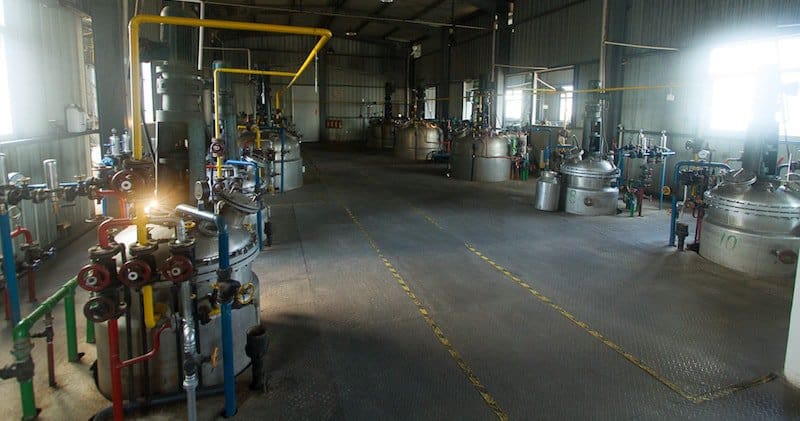
These anamorphs were studied extensively and found to produce similar results to wild Cordyceps sinensis. This ended up turning into what is now known as Cordyceps Cs-4. After undergoing clinical studies in China, the Chinese government approved its use in TCM (Traditional Chinese Medicine) hospitals, and it is now recognized as a safe natural product in China.
If a Cordyceps supplement is claiming to be Cordyceps sinensis and it is made in China, it is almost certainly Cordyceps Cs-4.
Other Cs-4 products may also be labeled as Paecilomyces hepiali, which is an anamorph form of Cordyceps sinensis.
Do not confuse Cordyceps Cs-4 (pure mycelium) with Cordyceps myceliated grain (below), as these are very different products.
Due to the fact that it is not economical to grow mushrooms in North America for supplement use, if a Cordyceps product is grown in North America, it is almost certainly Cordyceps myceliated grain.
Myceliated grain can also go by mycelium on grain (MOG), mycelium biomass, or grain spawn.
Myceliated grain products are typically labeled as Cordyceps sinensis or Cordyceps militaris.
Instead of growing the mycelium in liquid like what is used for Cordyceps Cs-4, the mycelium is instead grown in a plastic bag containing sterilized grain. This can also be referred to as solid-state fermentation.
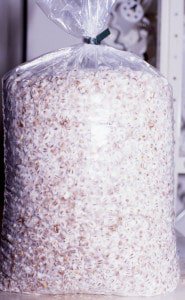
The issue here is that unlike being in liquid, the mycelium cannot be separated from the grain, so the grain ends up in the final product. This reduces the volume of desirable Cordyceps compounds found in the final supplement product.
With mycelium-on-grain products, the mycelium does not fully consume the grain, so much of the final product is actually the grain the mycelium grows on. This is most apparent with Cordyceps mushrooms, as it is a slow-growing fungus.
From the table below, you see a high amount of alpha-glucans, which represent starch from the grain. Starch is an alpha-glucan. Therefore, the grain medium the Cordyceps mycelium grows on is nowhere close to being fully consumed by the fungus.
The high amount of grain translates into a low amount of mycelium, and this is confirmed in the low beta-glucan numbers. This is why it is important to measure beta-glucans and not polysaccharides for functional mushroom products. These samples can tout high polysaccharide numbers (beta + alpha), but the majority of them come from non-beneficial starches, which are alpha-glucans.
Beta-glucan and Alpha-glucan results of Cordyceps mycelium grown on grain: (3,4).

Myceliated grain is often justified by referencing research on pure mycelium made through liquid fermentation.
As pointed out above with Cs-4, Cordyceps myceliated grain is very different from Cordyceps Cs-4, so using Cordyceps Cs-4 research to justify the use of Cordyceps myceliated grain is not valid and is misleading to the consumer.

There is currently one type of Cordyceps species that can be commercially cultivated at scale to produce a mushroom (fruiting body), and it is becoming quite popular for its potential benefits for human health. This is Cordyceps militaris. By using Cordyceps militaris, for the first time, true Cordyceps mushroom extracts can be made.
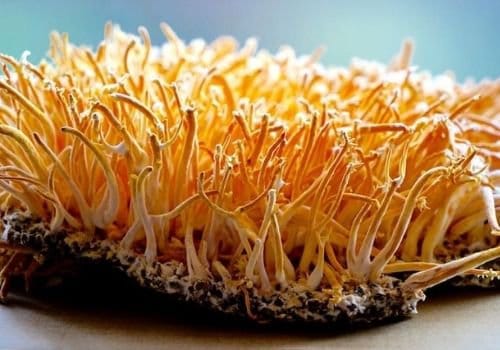
Since they are derived from the mushroom (versus the mycelium), there are much higher levels of the important beta-glucans.
Our Cordyceps-M product is extracted exclusively from organic Cordyceps militaris mushrooms and has greater than 25% beta-glucans. Compare that to Cs-4, which typically has less than 10% beta-glucans, and Cordyceps mycelium on grain, which typically has 1-3% beta-glucans.
One of the unique things about Cordyceps militaris is that it produces the compound cordycepin (3′-deoxyadenosine) in much higher amounts when compared to Cordyceps sinensis.
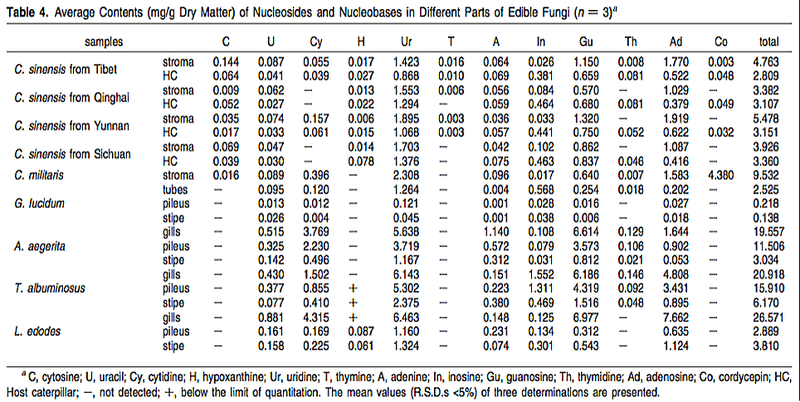
As seen from the table above, Cordyceps militaris has up to 90 times more cordycepin (column “Co”) when compared with the wild Cordyceps sinensis. Cs-4 would likely have even less cordycepin than wild Cordyceps sinensis, and Cordyceps mycelium on grain would have almost no cordycepin due to the low amount of mycelium present.
This is very important, as products touting the health benefits of cordycepin and labelled as Cordyceps sinensis would likely have undetectable amounts of this phyto-nutrient. Either that, or the product is improperly labelled as Cordyceps sinensis when it is actually Cordyceps militaris, which, by the way, is against FDA regulations and very misleading to consumers.
Note that Cordyceps militaris products grown in North America are still myceliated grain and not a true mushroom extract. Pure mushroom extract powders almost solely come from Asia, with China accounting for over 90% of the world’s mushroom production.
More and more research is coming out showing that Cordyceps militaris has similar health benefits to traditional wild Cordyceps sinensis. It has traditionally been used as an alternative to Cordyceps sinensis in Traditional Chinese Medicine.
Cordycepic acid is not to be confused with cordycepin, which is a unique compound in Cordyceps. Many Cordyceps products talk about Cordycepic acid (sometimes spelled Cordyceptic) as a beneficial compound in Cordyceps. But this was debunked back in the 1960s as not being a compound unique to Cordyceps, but a compound that is found in all functional mushrooms, which is D-Mannitol or Mannitol (1).
Other nucleosides like adenine, adenosine and uridine, which are commonly touted in Cordyceps, are also found in other fungi as well (see table above).
Cordyceps mushroom extracts may interact with anti-coagulant, immunosuppressant, hormone replacement, and prednisolone medications.
Cordyceps supplements may be contraindicated in breast and prostate malignant growths until further studies are performed (59).
In Traditional Chinese Medicine, Cordyceps is contraindicated in acute fever, flu, or other conditions.
The typical dosage in the scientific literature is 1-3 g/day of Cordyceps extract powder. However, this depends on the form of Cordyceps supplements and their potency.
Generally speaking, higher doses have been found effective in research. One human clinical study used 4g/day for exercise performance enhancement (47). Even higher doses of cordyceps supplements can be considered for specific immune system support with the recommendation of a medical professional.
Cordyceps are considered a generally well-tolerated herbal supplement with limited side effects. Some users may experience mild diarrhea, constipation, and abdominal discomfort, which may be decreased by taking Cordyceps supplements after a meal. There has been one case of a slight decrease in kidney function in an already compromised individual (60).
Cordyceps supplements may cause anxiety in some individuals due to their energizing nature; it has been shown to increase ATP production in rodents (8). An individual’s constitution and adrenal function status should be considered when taking cordyceps supplements.
The easiest way to take advantage of Cordyceps militaris mushrooms' health benefits is to use an extract. Real Mushrooms provides Cordyceps supplements in capsule or powder form and as part of an energy-boosting blend.
The cell wall of mushrooms is made up of chitin, which is the same substance that makes up crab shells. By extracting the mushrooms, this chitin will break down, allowing the body to have better access to the active constituents.
Extracting Cordyceps mushrooms produces a powder that is highly concentrated in bioactive compounds like beta-glucans and cordycepin. This is the method that Real Mushrooms uses with our organically-farmed mushrooms to produce the potent supplements we offer.
In comparison, eating Cordyceps militaris mushrooms or using a myceliated grain-based Cordyceps supplement will provide much smaller concentrations of the beneficial constituents.
While Real Mushrooms offers simplicity of use by offering encapsulated Organic Cordyceps Extract Capsules, we also offer pouches of Organic Cordyceps Mushroom Extract Powder, so the extract can easily be incorporated into healthy recipes. Once you discover the pleasure of taking our Cordyceps powder, the sky's the limit for its uses in smoothies, stews, coffee, stir frys, and other meals and drinks.
To spark your creative application of this mushroom powder in your diet, read our article assembling our tastiest recipes using Cordyceps extracts.
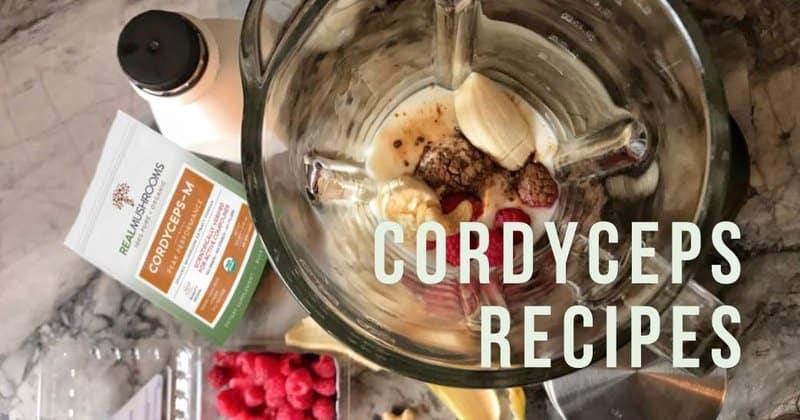
In Traditional Chinese Medicine, Cordyceps addressed respiratory complaints, physical exhaustion, and weak constitutions. It is also renowned for enhancing sexual function, libido, and performance.
Purported health benefits of cordyceps supplements include improving exercise performance biomarkers, supporting a healthy inflammation response, maintaining balanced blood sugar levels, and anti-aging benefits.
When selecting a Cordyceps mushroom product, it is very important to know exactly where it came from and how it was made. Scrutinize the label and Supplements Facts panel very carefully.
Here are 6 primary takeaways to remember about Cordyceps supplements:
We always recommend selecting cordyceps supplements and powders that are extracted from the mushroom (fruiting body), ideally certified organic, with measured levels of beta-glucans, like our very own Cordyceps mushroom extract.
For more information about buying mushroom supplements and what to look out for, visit our article on the difference between mycelium and fruiting bodies for medicinal uses.

*Disclaimer: The statements made in this article have not been evaluated by the Food and Drug Administration. Any products mentioned are not intended to diagnose, treat, cure, or prevent any disease. The information in this article is intended for educational purposes. The information is not intended to replace medical advice offered by licensed medical physicians. Please consult your doctor or health practitioner for any medical advice.
 .
.Disclaimer: The information or products mentioned in this article are provided as information resources only, and are not to be used or relied on to diagnose, treat, cure, or prevent any disease. This information does not create any patient-doctor relationship, and should not be used as a substitute for professional diagnosis and treatment. The information is intended for health care professionals only. The statements made in this article have not been evaluated by the Food and Drug Administration. Any products mentioned are not intended to diagnose, treat, cure, or prevent any disease. The information in this article is intended for educational purposes. The information is not intended to replace medical advice offered by licensed medical physicians. Please consult your doctor or health practitioner for any medical advice.